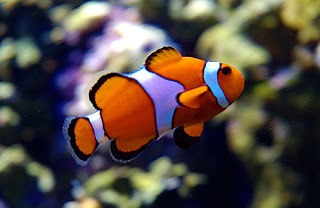 |
| (http://rhodeslab.beckman.illinois.edu/fish/clownfish.jpeg.jpg) |
In 2003, the hit Disney Pixar movie "Finding Nemo" catapulted clownfish into the public eye. The tiny orange and white fish became famous overnight. The clownfish contributes much to the economy of many countries with large demand for the fish in the exotic aquarium trade as well as their draw of tourists to the world's coral reefs. Unbeknownst to most, our every day actions may be inadvertently putting the clownfish at risk of extinction. Climate change due to anthropogenic influences has been quickly changing the chemistry and structure of the ocean, the very home of the much adored clownfish. Without immediate mitigation efforts, we may very well witness the disappearance of the species all together.
THE CLOWNFISH
Quick Facts
-28 different species-Omnivorous
-Species depicted in "Finding Nemo" is A. ocellaris
-may seem like they are "clowing around", but are actually very aggressive
(Clown Fish, Clownfish Biology, Amphiprioninae)
Habitat
Clownfish can be found in the warm salt water environments of the Pacific and Indian Oceans. As shown in "Finding Nemo", species of clownfish can be found off the coast of Australia within the Great Barrier Reef (Clown Fish, Clownfish Biology). |
(http://www.asknature.org/images/uploads/strategy/
|
Reproduction
Clownfish are hermaphrodites. They live in a hierarchy of sexual dominance with a head female fish, a breeding male and many younger male fish making up the rest of the group. Clownfish all begin life as males. If the head female dies, the breeding male has the ability to switch genders to become female and one of the other males of the group will become the breeding male (Clown Fish, Clownfish Biology, Amphiprioninae).Dangers to Clownfish
Clownfish are vulnerable to predators like large fish, sharks and eels. Additionally, they are at risk from the increase in human capture for personal aquariums (Clown Fish).Though natural predation is a factor in limiting clownfish populations, ocean acidification due to climate change may have a negative impact on clownfish populations well above and beyond current dangers. Since clownfish are such a huge player in the balance of the world's coral reef ecosystems and their presence has such a huge economic benefit for humans, the effects of climate change on their populations should be a high priority. Immediate mitigation efforts are imperative if we wish to share the beauty of the species with later generations.